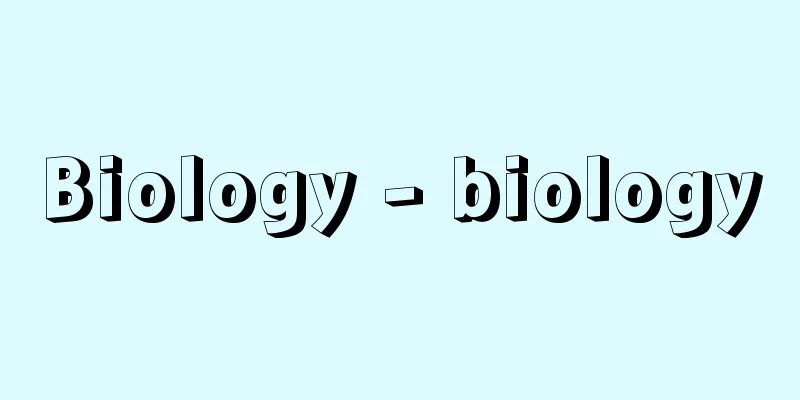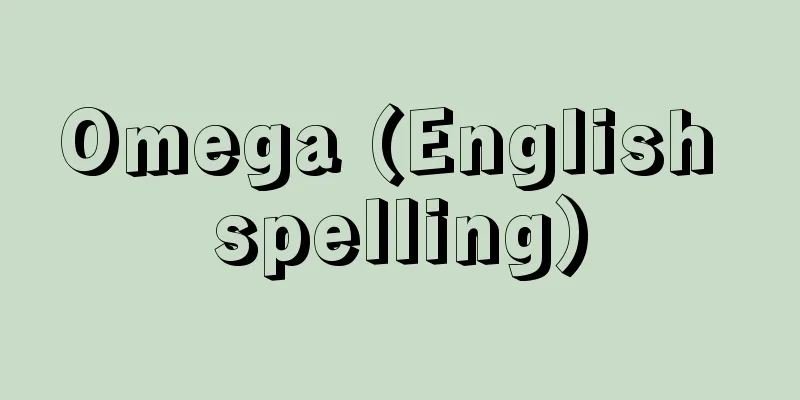Biology - biology

|
The science of living things. Also called biology. A natural science that focuses on the investigation of the essence of life phenomena common to all living things, but can also refer to a broad field that includes specific theories based on the diversity of living things. It can also be used to refer to physics, chemistry, earth science, etc. within the field of natural science. [Nobuo Egami] History of BiologyHumans have had a deep relationship with living things since ancient times, and living things are inseparable from human life, especially as materials for food, clothing, shelter, and tools. Therefore, a lot of knowledge about living things has been accumulated since ancient times. However, it was Aristotle of ancient Greece who organized general laws about living things as a subject of intellectual interest, apart from practical purposes, and many people call him the father of biology. After that, after passing through the dark ages of the Middle Ages, biology gradually made progress, but it took a much longer time for it to take on a new form as a science than other fields of natural science. The term "biology" itself was coined simultaneously in 1802 by J. B. Lamarck of France and G. R. Treviranus of Germany. They recognized the importance of the "life process" common to both animals and plants, and used the term when they woke up to a new science in terms of research methods and speculation. In the early days, biology was often divided into two major fields: "morphology," which focuses on the study of form, and "physiology," which focuses on function. However, today, even from a more microscopic perspective, the two are increasingly being considered as one. [Nobuo Egami] Biology SubjectsBiology is broadly divided into zoology, botany, microbiology, etc. based on the subject of study, and sometimes further subdivided into vertebrate zoology, entomology, ichthyology, etc., but these specific fields are not usually called biology. On the other hand, it can also be divided based on the level of the subject. That is, environmental biology, ecology, population biology, and evolutionary science, which clarify the interrelationships between the many organisms living on Earth, the relationship between the environment and organisms, and the temporal transition of biological communities, and view organisms as groups, study individual organisms or their organs and tissues, and cell biology, which studies organisms at the cellular and subcellular levels, and molecular biology, which looks at organisms at the molecular level. These fields also differ in their views of organisms and their research methods. Biology is also effectively divided into natural history fields that place emphasis on observation and intuition in the field, and analytical fields that study organisms in laboratories. [Nobuo Egami] Recent trendsAround 1950, the basics of life phenomena began to be understood at the molecular level, and the so-called central dogma of molecular biology was established, which significantly transformed the conventional scientific view of life and brought about major changes in biology. The basic conviction that it is possible to explain and understand life phenomena using common knowledge and terms with physics and chemistry was given material support. That is, the main body of genes, which are the basis of heredity, is deoxyribonucleic acid (DNA), which, due to its chemical structure, replicates itself. Meanwhile, the genetic information of an organism is contained in the order of the arrangement of the four bases that make up this molecule: adenine (A), guanine (G), cytosine (C), and thymine (T). In cells, this code is copied exactly into a molecule called ribonucleic acid (RNA), and specific proteins are synthesized based on the instructions, and these proteins perform various functions of the organism. This code and its functions are completely common to organisms from bacteria to humans. Furthermore, the functions of proteins synthesized in this way, such as the function of enzymes, the mechanism of movement of contractile proteins, and the mechanism of photosynthesis, all follow the laws of physics and chemistry, and there are no laws that are unique to living organisms. In this way, things that were previously thought have been clarified with actual material support, and it is generally recognized that biology shares a common foundation with other natural sciences. In other words, it has been discovered that all living organisms share a material commonality, and that this is governed by laws common to other natural sciences. [Nobuo Egami] Current BiologyToday's biology is not only important as a basic science; the boundaries between it and medicine, agriculture, etc. are merely expedient; it has a wide range of applications and is important as the foundation of industry and as it holds the key to solving many of the problems facing humanity as a member of the biological world, such as environmental issues, population issues, and food issues. Today, when biology is referred to as biological science, life science, bioscience, etc., these terms may be completely synonymous, but there may also be slight differences in nuance. They often refer to new biological sciences or to the parts of biology that are closely related to human life. [Nobuo Egami] History of BiologyThree stages in the history of biologyThe development of our understanding of biological phenomena, that is, biology in a broad sense, has gone through three major stages. The first stage was the phenomenological stage, a period in which specific and immediate knowledge of individual biological phenomena was accumulated. In the history of biology as a whole, this is typified by the period of natural history. Strictly speaking, this was a pre-scientific period, but in its final period (from the 17th to the 19th century), many factors that led to the leap to the next stage, that is, the scientific revolution in biology, appeared. The second stage is the ontological stage, in which all complex and diverse biological phenomena are generalized and understood in the form of laws, and knowledge is organized. To achieve this, methods of (chemical and mathematical) analysis are developed, and contact with physics and chemistry is strengthened. This is the period after the scientific revolution when biology first rapidly developed with the characteristics of modern science, and it began in the 1970s and continues to the present day. If the previous stage is defined as the period of research into the self, then this stage can be called the stage of research into the self. The third stage is the essentialist stage, in which the essence of life begins to be pursued scientifically, in and for itself, and the present age is the transitional period to this stage. [Sato Shichiro] The origins of biologyThe accumulation of knowledge about living things is considered to have begun almost simultaneously with the origin of humanity. Primitive humans, who had no choice but to rely entirely on hunting and collecting other living things for their diet, gradually began to accumulate and pass on knowledge about primitive plants and animals, out of an instinctive interest in their species, developmental processes, behavior, and distribution. The satisfaction of the conditions for a diet was an absolute requirement that took precedence over other needs such as clothing and shelter, which is why the intellectual development of primitive people began first with the accumulation of empirical knowledge about living things. This was the premise that made it possible to begin agriculture in the Neolithic period, and there is no doubt that agricultural experience led to an ever-increasing knowledge of living things. [Sato Shichiro] Inspiration for LifeHumans have lived in relatively small groups since the Paleolithic period. With the development of productive forces, the bonds within the group gradually strengthened, and the spiritual ties between individuals who shared the same bed and meal also deepened. This gave rise to the sense of the soul, and totems as symbols of group unity, and rituals and magic as a means of confirming unity were created. These also fostered ideas about life, as a compensation for the lack of medical science, which had been stagnating significantly in contrast to the development of productive forces. People desired a deeper understanding of human life as their own inner experience, but unfortunately, because human life was the most highly structured of all living things, the difficulty of understanding was inversely proportional to the seriousness of the desire to understand it, and this effort to understand it had no choice but to take the form of primitive religion. Thus, a materialistic understanding of living things through production and an idealistic understanding of life through the barriers of human understanding co-existed, sometimes in conflict with each other, a situation that remained essentially unchanged throughout the Antiquity and Middle Ages, through the Bronze and Iron Ages. [Sato Shichiro] The pulse of modernizationIn the Middle Ages, as the ruling class was established, the expectations of the class towards medicine increased. To meet these expectations, it was necessary to know the structure of the human body, and human dissection, which had been prohibited mainly for religious reasons, came to be carried out under strict restrictions. Since ancient times, attempts to cultivate and collect medicinal plants and their medicinal uses have led to the accumulation of knowledge about plants, but in the Middle Ages, botanical observation as a hobby among aristocrats became popular, and people began to collect biological knowledge that had no practical value, which led to the formation of natural history. The domination of Africa and Asia by European countries spurred the discovery and collection of rare plants and animals, and natural history led to the rapid accumulation of knowledge about animals and plants. This laid one of the foundations of modern biology. [Sato Shichiro] The impact of the Scientific RevolutionIn the 17th century, when modern science was established with physics at its core, this had a strong impact on biology. There were repeated attempts to empirically understand biological phenomena using empirical methods and strict logic. Notable examples of this were the experimental proof of blood circulation by the Englishman Harvey (1628) and the discovery of the cell by R. Hooke (1665). Harvey conducted rigorous reasoning and clear experiments regarding the flow of blood in the human body. That is, he believed that the amount of blood flowing from the heart to the arteries in a certain period of time was greater than expected, and therefore blood must circulate within a closed space. It is noteworthy that he used quantitative logic here, which was a new style of reasoning influenced by Galileo. He then tied a human's arm with a string, so that the blood flow in the arteries did not stop but that in the veins did, and observed the change in the amount of blood in the veins. As a result, blood accumulated in the veins between the heart and the tied part, and there was almost no blood in the veins on the opposite side. From this result, he concluded that blood leaves the heart and enters the arteries, then from the arteries into the veins and returns to the heart. Thus, the theory of human blood circulation was brilliantly proven and established. This is an achievement that is still valid today. On the other hand, R. Hooke, a professor of geometry at Oxford University, was interested in the remarkable elasticity, lightness, and stability of cork, and tried to find the cause of this. In doing so, he avoided delving into the traditional speculations about the reason and significance of cork's existence, and instead sought the cause within cork itself. This was because his philosophy was that experience was the best way to solve the mysteries of nature and reveal the truth. He made thin slices of cork and observed them with a microscope he had made himself. The reason he used a microscope was that by expanding human senses with a tool, it became possible to have broader and deeper experiences. He discovered cells in the slices. He was convinced that by elucidating the fact that cork is a collection of cells, he had been able to understand the properties of cork as a material, and he believed that the correctness of his scientific methodology was guaranteed. He also observed thin slices of charcoal and several types of living plants under a microscope, and found that cells were found in both cases. In addition to these two, a great number of pioneering research projects were produced during this period, including Malpighi's discovery of capillaries (1661) and red blood cells (1668), Swammerdam's detailed observations of insects (1658), Leeuwenhoek's observations of microscopic organisms (1675, 1680) and sperm (1677), R. Graf's study of pancreatic function (1664), Boyle's study of respiration (1660), Borelli's study of the dynamics of movement (1680), Sydenham's research into empirical medicine, and Camerarius' study of the reproductive organs of plants (1694). A common feature of these studies was their attitude of attempting to explain biological phenomena empirically and empirically, and one can see the influence of the scientific revolution that was taking place at the time, centered around physics. [Sato Shichiro] The Limitations of 17th Century BiologyThese facts give the impression that a new era had arrived in biology, or in other words, that a revolution had taken place in biology. In fact, some historical views hold that biology was modernized in the 17th century. However, this is a superficial view, and when we look at the era that followed, it becomes clear that this view is incorrect. Despite Harvey's brilliant experimental proof, no new theory was derived from this discovery to solve any other problems in biology. Harvey's methodology was based on analogy with pumps and had no universal validity for solving the mysteries of biological phenomena. In the same period, Descartes highly praised Harvey's experiments and tried to explain the nervous system by applying Harvey's theory, but without any success. Hooke's discovery of cells did not establish the position of cells as the basic structure of living organisms, nor did it foster new biological research based on this. Microscopic observation of living organisms became more common thereafter, and by the end of the 18th century, knowledge of the microscopic structure of the human body had deepened in medicine, but the emphasis was on tissues rather than cells. Another example that shows the advanced nature of biology at the time, as well as its pre-modern nature, is the view of species by the British taxonomist J. Ray. Ray wrote an excellent monograph on British plants and animals, in which he expressed a view of species that is considered to be the basis of experimental taxonomy today, that organisms that can produce offspring that closely resemble their parents through mating are considered to belong to the same species. He even acknowledged that the characteristics of species are not fixed and unchanging. Nevertheless, he was unable to escape from the view that the number of species has been constant since God's creation. Herein lay the limitations of the progressive biology of that era, limitations which would become more evident in a reactionary way in the following century, especially in its first half. It is well known that the 18th century was a great century for travelers, collectors, and taxonomists. The results of overseas explorations dramatically enriched our knowledge of living organisms as new knowledge. In particular, knowledge of organisms in tropical regions made it interesting to consider the relationship between the distribution, geography, and geology of organisms. In the midst of this, Linnaeus showed the principles of plant classification and established the foundation of taxonomy that continues to this day (1751). However, he was unwilling to abandon his belief that species are related to God's creation and are unchanging. He could not challenge the view of nature that all of nature was created to reveal the wisdom of the Creator. Therefore, Linnaeus' species could not basically go beyond "kinds." These facts prove that no modern revolution in biology took place during this period. [Sato Shichiro] Conditions for Biological ModernizationAs mentioned above, during the 17th and 18th centuries, under the influence of physics (and chemistry), which had completed their scientific revolution earlier and achieved modernization, there were sporadic instances of modern scientific characteristics being seen in the study of biological phenomena. However, as individual works, these did not mature enough to build modern biology. The time finally began to ripen in the 19th century. To get straight to the point, biology was able to achieve modernization in the 1970s thanks to the establishment of the following five conditions. These five conditions are the cell theory, the species concept, and the establishment of the theory of evolution, the denial of the theory of spontaneous generation of organisms, and the denial of supernatural life forces. The cell theory was conceived by Schleiden and summarized in On the Development of Plants (1838). Its main point was that the cells that make up a plant body have a common structure, and based on the observational fact that as a plant body develops and forms, the constituent cells increase in number and change in form, the building blocks of the plant body are cells, not tissues as previously thought. This idea resonated with Schwann, who was observing the structure of animal bodies under a microscope. Schwann applied Schleiden's theory to animals, and with more detailed observational facts and more precise arguments, he argued (1839) that the cell theory is a general law that applies to both plants and animals. This cell theory was quickly accepted, but it had one major flaw: a dogmatic misunderstanding of the way cells multiply. Schleiden emphasized that a cell always contains a nucleus, but he also proposed a theory of intracellular cell formation, stating that a nucleolus exists inside a nucleus, and that these dots sometimes appear inside a nucleolus, and that these dots then become nucleoli, which then become nuclei, and then new nuclei. This error was quickly noticed by other researchers, and soon after the discovery of nuclear division and cell division, cell division and multiplication was generally accepted, and the cell theory was established. However, Schwann stubbornly refused to accept this division, stubbornly insisted on his own theory, and distanced himself from academia. It became clear in the latter half of the 1800s that the significance of nuclear division is to distribute genetic carriers equally to daughter cells, and this is considered to have established the cell theory. Since species are the standard unit for classifying living organisms, the most fundamental problem in taxonomy is how to define them. Rey, Linnaeus, and Tournefort discussed this issue, but none of them could get away from the formal argument. Therefore, species was merely a category of kinds in the biological sense. It could not be the subject of discussion on what kind of internal structure species have or what kind of driving force causes them to change and develop. The idea of biological evolution appeared at the beginning of the 19th century (Lamarck, 1809), but the discussion did not extend to the driving force behind the change in species, and therefore it was not accepted in biology. C. Darwin's On the Origin of Species (1859) broke through this obstacle. Darwin was the first to regard species as not just types, but as units of historical development called evolution, and by reconsidering them in this way, it became clear that species are entities with internal structure. The establishment of the species concept as a substantial concept came with the establishment of the theory of evolution, which officially recognized that all living species have a historical basis for their existence, that all species have a common ancestry, and therefore that their apparent relationships have a substantial basis, regardless of any debate about the mechanism of evolution. The possibility of spontaneous generation of living organisms had been experimentally examined since the 17th century, but after some twists and turns, it was completely denied experimentally by Pasteur in 1861. This experiment guaranteed the reliability of subsequent biological experiments and made strict quantitative observation of living organisms possible. The achievement of this research goes beyond simply enlightening people about the meaning of sterilization and its methods. Finally, living things exhibit numerous complex phenomena that are qualitatively different from inorganic matter, and although at first glance they may give the impression of not following the laws of thermodynamics or certain laws of chemical reactions, they in no way contradict the laws of physics or chemistry. This is an absolute premise of modern physics, but it has not been achieved through a process of being definitively clarified by the results of specific research or the development of a theory. The development of thermodynamics since the early 19th century, and the development of chemistry, particularly organic chemistry, led to the discovery of pepsin (Schwann, 1836), the presence of oxygen and carbon dioxide in blood (Theodor Ludwig Wilhelm Bischoff, 1837), the role of glycogen in energy metabolism (Bernard, 1855), fermentation (Pasteur, 1857, 1859), protein digestion (Voyth, 1860), and the relationship between photosynthesis and starch (Sachs, 1865), and in particular the successful systematization of biochemistry by Hoppe and Sailer based on these findings, solidified the conviction that the laws of physics and chemistry are also applicable to living organisms. The recognition that biological phenomena are governed by the laws of physics and chemistry gave biology a materialistic foundation, but at the same time qualified it as a branch of science. This completely eliminated any room for the kind of vitalism that had haunted biological phenomena since ancient times and prevented a correct understanding of them to once again invade biology. In fact, even after the turn of the 20th century, there were times when vitalism in the form of holism seemed to be reviving, but it all vanished like an illusion. [Sato Shichiro] Developments in Modern BiologyAs the above five assumptions were realized almost in tandem, new issues arose. These issues became the motivation for the establishment and development of modern biology. Here are some examples. First, if the principle that all biological phenomena are governed by physical and chemical laws is accepted, it gives rise to the intriguing expectation that all the complex and seemingly purposeful activities of living organisms, from development, differentiation, heredity, and movement, to sensation and thought, should be fully explainable by those laws. This interest motivated the rapid development of biochemistry, one of the defining features of 20th century biology. It succeeded in discovering the chemical phenomena underlying some aspects of biological phenomena and in elucidating their material causal relationships. This revived the mechanistic reductionism that had once flourished in the 17th century but then completely died out. Secondly, there is a contradiction between the cell theory and the theory of evolution. The cell theory was not fully established at the stage proposed by Schleiden and Schwann, and was only established after cell division (which is based on nuclear division) was officially recognized. This fact shows that the cell theory includes the recognition that cells are the entities that maintain and transmit life across generations. In the process of this recognition, it was revealed that all sexual reproduction is the combination of a single-celled egg and sperm, which should have strengthened the above-mentioned implications of the cell theory. This recognition grasps the immutability of cells and guarantees that an individual member of a species can produce the next generation of individuals as members of the same species, thereby maintaining the species historically. On the other hand, the theory of evolution testifies to the mutability of species. Changes in species must necessarily presuppose changes in the individuals that are substantial members of the species, and by the same logic must presuppose the mutability of cells. This is the contradiction between the cell theory and the evolution theory. This contradiction was resolved by the study of heredity. Genetics first combined with cytology. It then discovered the legal correspondence between chromosomes and the characteristics of individuals (which are also the characteristics of species), forming cytogenetics. In the process, it learned about chromosomal mutations, and grasped the basis for the variability of species within cells that remain constant. Chromosome research has since progressed to the molecular level, attempting to elucidate the stability and instability of species, and thus the material basis of evolution. However, the study of evolution in this way faced a more fundamental problem: the mechanism of nuclear division, and especially the mechanism of meiosis. Although some hypotheses were proposed and experimental studies were conducted on the former, almost no research was conducted on the latter, and the problem was left unsolved until now. One could say that the reason for this was the difficulty of solving the problem, but the more fundamental reason was that in the second half of the 20th century, genetics progressed mainly with bacteria that do not reproduce sexually (and therefore do not require meiosis), and it was combined with biochemistry to open up a new field as genetic biochemistry. Genetic biochemistry discovered nucleic acids as a means of transmitting information in living organisms, which became a catalyst for new developments in biology. Because of the brilliance of this development, some people tend to describe the beginning of genetic biochemistry as a revolutionary change and modernization of biology, but this is not correct. Although it is true that the function of nucleic acids as an information substance was unexpected, it cannot be called revolutionary since it did not contradict any of the officially recognized norms of biology or chemistry. It is simply the result of the modernization of biology that took place in the 1970s. Thirdly, Darwin's theory of evolution teaches that if we trace the history of living things back, we will approach an infinitely primitive form, and suggests that living things will eventually emerge from non-living things, whereas Pasteur's experiments deny the spontaneous generation of living things. How to resolve this contradiction became an issue, but Oparin resolved it by affirming both Darwin's and Pasteur's positions (1936). This issue is related to the formation of cells, individuals, and species, and has provided an opportunity to reconsider cells, individuals, and species. Fourth, Darwin's theory of evolution appeared in the world using the theory of survival competition as a trump card, but the theory of survival competition itself was raised from the beginning, and it was not fully defended by Darwin himself. This remains a major issue for the future. One of the reasons that must be left is that modernized biology has been immersed in reductionism at the stage of substantive theory, which is based on the a priori presupposition of the mechanisms of biological phenomena, and that the pursuit of the laws at the level of individuals as structural elements of species was delayed. This latter is the problem today in so-called population ecology. Ecology originally began as a study of individuals or population responses to the environment, and to this extent it did not leave the physiology of populations. However, later, by diverging animal behavioral science and pioneering research into population dynamics, it became a unique field that characterizes modern biology in contrast to biochemistry, and inevitably has a close connection with evolutionary science. [Sato Shichiro] "The History of Biology" III by G. R. Taylor, translated by Yabe Ichiro et al. (1976, 1977, Misuzu Shobo)" ▽ "The History of Biology" by Nakamura Teirato (1973, Kawade Shobo Shinsha)" [Reference Item] |Source: Shogakukan Encyclopedia Nipponica About Encyclopedia Nipponica Information | Legend |
|
生物に関する科学。バイオロジーともいう。とくにすべての生物に共通した生命現象の本質の究明に主点を置いた自然科学であるが、生物の多様性に基づく各論も含んだ広範な分野をさすこともある。また、自然科学の領域のうちで、物理学、化学、地学などに対して用いる場合もある。 [江上信雄] 生物学の沿革人類は遠い昔から生物と深い関係をもち、とくに食料、衣料、住居や道具の材料としての生物は、人間の生活と切り離せないものであった。したがって生物に関する個々の知識は遠い昔から多く集積された。しかし実用上の目的を離れ、知的興味の対象として生物に関する一般法則が整理されたのは、古代ギリシアのアリストテレスによるところが大きいので、彼を生物学の祖とよぶ人も多い。その後、中世の暗黒時代を経て、生物学は徐々に歩みを進めてはきたが、科学として新しい姿をとるようになったのは、自然科学の他の分野に比べてずっと遅れ、「生物学」という用語自体は、フランスのJ・B・ラマルク、ドイツのG・R・トレビラヌスによって1802年に同時につくりだされた。彼らは動物、植物に共通の「生命過程」の重要性を認識し、研究の方法の点でも思索の点でも新しい科学に目覚め、この用語を使った。初期には生物学を、形態の研究を中心とする「形態学」と、その機能に目を向ける「生理学」とに二大別することがしばしば行われたが、今日ではより微視的な立場からみても、両者は一体として考えられるようになりつつある。 [江上信雄] 生物学の対象生物学をその研究対象から、動物学、植物学、微生物学などに大別し、さらにより細かい脊椎(せきつい)動物学、昆虫学、魚類学などというように細分する場合もあるが、普通はこのような各論はむしろ生物学とはよばない。一方、対象の水準から分けることもある。すなわち、地球上に生息する多数の生物の相互関係や、環境と生物との関係を明らかにし、生物群集の時間的遷移などを知り、生物を集団としてとらえる環境生物学や生態学や集団生物学や進化学と、個々の生物個体またはそのなかの器官や組織の水準の研究と、さらに細胞や細胞下の水準の研究をする細胞生物学、さらには分子の水準から生物をみる分子生物学などの立場である。これらは生物に対する見方や研究方法の点でも相違がみられる。生物学を、主として野外での観察や直観に重きを置いた自然史的分野と、実験室内での分析的分野とに分けることも実質的には行われている。 [江上信雄] 近年の動向1950年ごろから、生命現象の基本が分子の水準で理解されるようになり、いわゆる分子生物学のセントラルドグマ(中心教義)が確立して、従来の科学的生命観は大幅に変貌(へんぼう)し、生物学にも大きな変化がおこった。生命現象を、物理学や化学と共通の認識と用語で説明し、理解してゆくことが可能であるという基本的確信が物質的な裏づけを得たわけである。すなわち、遺伝の基礎となる遺伝子の本体はデオキシリボ核酸(DNA)であり、これはその化学構造上の必然性から、自己と同じものを複製する。一方、この分子を構成するアデニン(A)、グアニン(G)、シトシン(C)、チミン(T)という4種の塩基の並び方の順序として生物の遺伝情報が暗号のように含まれている。細胞の中ではこの暗号はリボ核酸(RNA)という分子にそっくり写しとられ、その指令に基づいて特定のタンパク質が合成され、このタンパク質が生物のもろもろの働きを行う。この暗号やその働きは、バクテリアからヒトに至るまでまったく共通である。また、このようにして合成されたタンパク質の働き、たとえば酵素の働きにしても、収縮性のあるタンパク質の運動の仕組みにしても、光合成の仕組みにしても、すべて物理学や化学の法則に従い、生物にだけ特有の法則があるわけではない。このように、従来から考えられていた事柄が、実際に物質の裏づけをもって解明され、生物学が他の自然科学と共通の基盤をもつことが一般に認められる。つまり、すべての生物が物質的共通性をもち、しかもこれが他の自然科学とも共通の法則下にあることがわかったのである。 [江上信雄] 現在の生物学現在の生物学は、基礎科学として重要であるだけでなく、医学、農学などとの境界も便宜的にすぎず、応用範囲は広く、産業の基礎として、また環境問題、人口問題、食糧問題など、生物界構成員としての人類が直面する多くの問題解決の鍵(かぎ)を握るものとして重要である。 なお今日、生物学を生物科学、生命科学、ライフサイエンス、バイオサイエンスなどとよぶ場合には、完全な同意語の場合もあるが、ニュアンスに若干の相違がある場合もある。とくに新しい生物学をさす場合や、生物学のうちでも人間生活との関係の大きい部分をさす場合が多い。 [江上信雄] 生物学の歴史生物学史の三段階生物現象に関する認識、つまり広義の生物学の発展の過程は、大きく分けて三つの段階を経てきている。 第一の段階は、現象論的段階であり、個別的な生物現象に関する個別的で即自的な知識の集積が行われた時代である。生物学史全体についていえば、博物学の時代にその典型をみる。厳密にいえば科学以前の時代であるが、その末期(17世紀から19世紀まで)には次の段階への飛躍、つまり生物学における科学革命の要因が数多く現れる。 第二の段階は、実体論的段階であり、複雑多様なあらゆる生物現象を法則の形で一般化して把握し、知識が整理される段階である。そのために(化学的・数学的)分析の方法が発達し、物理学・化学との接触が強まる時代である。科学革命を終えて生物学が初めて現代科学の様相をもって急速に発展する時代であり、19世紀の70年代に始まり、現代に及んでいる段階である。前段階を即自的な研究の時代と規定するならば、この段階は対自的な段階ということができよう。 第三の段階は、本質論的段階である。生命の本質が科学的に、即自・対自的に追究され始める段階であり、現代がこの段階への移行の時代である。 [佐藤七郎] 生物学の発端人類の、生物にかかわる知識の集積は、人類の起源とほとんど同時に開始されたとみなされる。すなわち、他生物の収集と狩猟とにその食生活を全面的に依存するほかなかった原始人類は、原生の植物・動物の種類、発育の過程、行動、分布などについての本能的関心から、しだいにそれらについての知識を蓄え伝承することを始めた。食生活のための条件の充足が、他の衣・住への要求に優先する絶対要件であったことが、原始人の知的な発達が、まず生物にかかわる経験的知識の集積から始まった原因である。 このことは新石器時代に入って農業を開始することを可能にした前提であったが、農業の経験を積むことによって、生物についての知識はますます増大したであろうことは疑いない。 [佐藤七郎] 生命への着想人類は旧石器時代から比較的小規模の集団生活を営んでいた。生産力の発展に伴い、集団のなかの絆(きずな)はしだいに強化され、それに伴い、寝食をともにする個人間の精神的な結び付きも深まった。ここから霊魂の感覚が生まれ、集団の結束の象徴としてのトーテム、結束を確認する手段としての儀式、呪術(じゅじゅつ)などが生み出された。それらはまた、生産力の発達と対照的に、著しい停滞を続けていた医術の欠如を補うものとして、生命についての観念を育てた。人々は自らの内的体験としての人間の生命についてのより深い理解を願望したが、不幸なことに、それはあらゆる生物のなかのもっとも高度な構造をもった存在であったがゆえに、その理解希求の深刻さに逆比例して、理解の困難さを体験させられることとなり、この理解のための努力は、原始的な宗教の形をとるほかなかった。こうして生産を通じての、生物に関する唯物的な理解と、人間理解の障壁を通じての生命の観念的な理解とが、ときには互いに争い合いながら同時進行することとなった。この状態は、青銅器時代、鉄器時代を通じる古代、中世の間も基本的に変わることがなかった。 [佐藤七郎] 近代化への脈動中世に至って支配階級が確立されるに及んで、階層としての医学への期待はますます増大した。その期待にこたえるためには、なによりも人体の構造を知る必要があり、主として宗教的な理由の下に禁じられていた人体解剖は、厳しい制約の下に実行されるようになった。 古代から試みられていた薬用植物の栽培と採集および薬効処理の経験は、植物に関する知識を蓄積したが、中世には貴族の趣味としての植物観察が盛んになり、実用から離れた生物知識の収集も行われるようになり、博物学を形成した。ヨーロッパ諸国のアフリカ、アジア地域支配は、珍しい植物・動物の発見、収集に拍車をかけ、博物学は動物・植物に関する知識の急速な蓄積をもたらした。これは近代的な生物学の土台の一つを築くことになった。 [佐藤七郎] 科学革命の影響17世紀に、物理学を中心として近代的様相を伴った科学が成立すると、これは生物学にも強いインパクトを与えた。生物の現象を経験的な方法と厳密な論理によって実証的に理解しようという試みが繰り返された。そのなかで代表的なのは、イギリスのハーベーによる血液循環の実験的証明(1628)と、R・フックによる細胞の発見(1665)である。 ハーベーは人体内の血液の流れに関して、厳密な推論と明快な実験を行った。すなわち彼は、心臓から一定時間内に動脈に流れ出す血液の量が想像以上に多いことから、血液は閉じられた空間内を循環しているに違いないと考えた。ここに定量的な論理が用いられ、これがガリレイの影響を受けた新しいスタイルの推論であることが注目される。ついで彼は、人間の腕を紐(ひも)で縛って、動脈の血流は停止しないが静脈のそれは停止するようにし、静脈内の血液量の変化をみた。結果は、心臓から、縛ったところまでの間の静脈内に血液がたまり、反対側の静脈内には血液がほとんどなくなった。この結果から、彼は、血液は心臓から出て動脈に入り、ついで動脈から静脈に入ってふたたび心臓に戻るのだという結論を得た。こうして人間の血液の循環説がみごとに証明され、確立したのであった。これは今日でも通用する業績である。 他方、オックスフォード大学の幾何学教授であったR・フックは、コルクという物質が著しく弾性をもち、軽く、しかも安定であるという特性をもっていることに興味を抱き、その原因を探ろうとした。その際、彼は、旧来繰り返されたようなコルクの存在理由・意義などに関する思弁に深入りすることを避け、その原因をコルク自体の内部に求めた。経験が自然の謎(なぞ)を解き、真実を明らかにする最高の方法であるというのが彼の哲学であったためである。彼はコルクの薄片をつくり、自製の顕微鏡で観察した。顕微鏡という道具を用いた理由は、人間の感覚を道具によって拡張することによって、より広くより深い経験が可能になるという点にあった。そしてそこに細胞を発見した。彼は、コルクが細胞の集団である事実を明らかにすることによって、コルクという物質の特性を理解することが可能になったと確信し、自らの科学方法論の正しさが保証されたと考えた。彼はさらに、木炭および数種類の生きた植物についても、その薄片の顕微鏡観察を行い、いずれの場合にも細胞が発見されることを知った。 以上2人のほか、この時期には、マルピーギによる毛細血管(1661)と赤血球(1668)の発見、スワンメルダムの昆虫の詳しい観察(1658)、レーウェンフックの微小生物(1675、1680)および精子(1677)の観察、R・グラーフの膵臓(すいぞう)機能の研究(1664)、ボイルの呼吸の研究(1660)、ボレリの運動の力学的研究(1680)、シデナムによる経験主義医学の研究、カメラリウスによる植物の生殖器官の研究(1694)など、おびただしい数の先駆的な研究が続出している。これらの研究の共通した特徴は、生物現象を経験的に、実証的に解明しようとする姿勢にあり、当時、物理学を中心に進行しつつあった科学革命の影響をみることができる。 [佐藤七郎] 17世紀生物学の限界これらの事実は、あたかも生物学に新時代が到来した、いいかえれば生物学の革命が起こったかのような印象を与える。事実、17世紀において生物学も近代化されたとみる史観もある。しかしそれは表面的な見方であって、これに次ぐ時代がどのような時代であるかをみれば、それが誤りであることが明らかである。 ハーベーのみごとな実験的証明があったにもかかわらず、この発見から生物の他のなんらかの問題を解決する新しい理論はなにひとつ導出されることがなかった。ハーベーの方法論はポンプとのアナロジーで成立しているものであって、生物現象の謎を解く普遍的な有効性はなかった。同時代に、デカルトはハーベーの実験を高く評価し、ハーベーの説を神経系に持ち込んで神経作用を説明しようとしたが、なんらの成功も得られなかった。 フックの細胞の発見も、生体の基本構造としての細胞の位置づけ、それを基盤とした生物研究の新しい芽を展開させたという事実はなかった。生体の顕微鏡的観察はその後盛んになり、18世紀末には医学において、人体の顕微鏡的構造の知識が深まったが、重点は細胞よりも組織に置かれていた。 実験的研究者ではないが、この時代の生物学の先進性とともに前近代性を示すものとして、いま一つの例をあげるならば、イギリスの分類学者J・レイの種についての見解がある。彼はイギリスの植物・動物の優れたモノグラフを書き、そのなかで、種について、交配によって両親によく似た子孫をつくりうる生物は、同一の種に属するものとみられるという、今日の実験分類学の基礎ともみられる種の見解を表明している。そして種の諸特徴が固定した不変のものではないことまでも認めていた。それにもかかわらず、種の数は神による創造以来、一定不変であるとする観点からは抜け出ることはできなかった。 ここに、この時代の進歩的な生物学の限界があった。そしてこの限界は、反動的に、次の世紀、とくにその前半において顕著に現れた。 18世紀が旅行家・採集家・分類家の偉大な世紀であったことはよく知られている。海外探検の成果が新知識として、生物に関する知見を飛躍的に豊富にした。とくに熱帯地方の生物についての知見は、生物の分布、地理、地質との関係についての考察を興味あるものにした。そうしたなかで、リンネは植物の分類の原理を示し、今日にまで及ぶ分類学の基礎を確立した(1751)。しかし彼は、種が神の創生にかかわるものであり、不変であるとの信仰を捨てようとはしなかった。全自然が創造主の英知を現すためにつくられたものであるという自然観に挑戦することはできなかった。そのゆえに、リンネの種は、基本的に「種類」以上のものに出ることはできなかった。 これらの事実は、この時代においても生物学の近代化の革命は起こっていなかったことを証している。 [佐藤七郎] 生物学近代化の条件既述のように、17世紀と18世紀の間、先んじて科学革命を終え、近代化を達成した物理学(および化学)の影響を受けて、生物現象の研究のなかにも、近代科学的な特徴の片鱗(へんりん)をみせたものが散発的に現れていた。しかしそれらは個々のものとしては近代的な生物学を築きあげるまでに成長しきれなかった。その機は19世紀に入ってようやく熟し始めた。結論を先にいうならば、生物学は次の五つの条件の整備によって、19世紀の70年代に近代化を達成することができた。その五つの条件とは、細胞説、種概念、進化論の確立、生物の自然発生説の否定、超自然的な生命力の否定、である。 細胞説はシュライデンが着想し、『植物の発生について』(1838)にまとめられた。その主眼は、植物体を構成している細胞には共通のつくりがあり、植物体が発育形成される際には、その構成細胞の数が増し、形態が変化していくという観察事実に基づき、植物体の構成単位は、従来考えられていたように組織なのではなく細胞である、というものであった。この考えは、動物体の構造を顕微鏡観察しつつあったシュワンの共鳴を得た。シュワンはシュライデンの説を動物に適用して、より綿密な観察事実とより緻密(ちみつ)な論述をもって、細胞説が植物・動物において適用される一般法則である旨を説いた(1839)。 この細胞説はただちに受け入れられたが、ただ一つ大きな欠陥があった。それは細胞の増殖の様式について独断的な誤解であった。シュライデンは細胞内にかならず核があることを重視したが、さらに、核の中に核小体があり、核小体の中に、ときに点状の箇所がみられることがあるのを根拠に、逆にこの点状の箇所が核小体となり、核小体が核となり、さらに新しい核になるのだ、という細胞内細胞形成説を唱えた。この誤りは他の研究者によってただちに気づかれ、まもなく核分裂・細胞分裂の発見によって、細胞の分裂増殖が一般に認められ、細胞説は確立した。しかしシュワンはこの分裂をあくまで認めず、頑迷に自説を主張し、学界から遠ざかった。核分裂の意義は遺伝の担荷体を娘細胞に均等分配するにあることは、1800年代の後半に明らかとなり、これをもって細胞説は確立されたとみられる。 種は生物の分類の基準単位である以上、それをどのようなものと規定するかは分類学上のもっとも根本的な問題であり、既述のレイやリンネのほか、トゥルネフォルなども論じたところであるが、いずれも形式上の論議から抜け出すことはできなかった。したがって、種は生物学的な意味での種類の一カテゴリーであるにすぎなかった。種がどのような内部構造をもち、どのような動因によって変化発展するのか、といった論議の対象とはなりえなかった。生物進化の着想は19世紀の初めから現れていた(ラマルク、1809)が、その論議は種の変化の動因にまで及びえなかったがために、生物学のなかで認められるには至らなかった。 C・ダーウィンの『種の起原』(1859)がこの難関を打ち破った。ダーウィンによって、種は初めて単なる種類ではなく、進化とよばれる歴史的発展の単位ととらえられ、そのように見直されることによって、種は内部構造をもった実体であることが明らかとなった。 実体概念としての種概念の確立は進化説の成立とともに行われた。これによって、あらゆる生物種がその存在の歴史的基礎をもっていること、そしてあらゆる種が共通の祖先をもち、したがってその外見上の類縁関係には実質的基礎があることが、進化の機構に関する論議は別にして、公認された。 生物の自然発生の可能性については、17世紀以来、実験的な検討がなされてきたが、いくつかの曲折を経て、1861年、パスツールによって実験的に完全に否定された。この実験はそれ以後の生物学の諸実験の信頼性に保証を与え、生物についての厳密に定量的な観測を可能にさせた。この研究の功績は単なる滅菌の意義とその手法の啓発だけに終わるものではない。 最後に、生物は無機物と質的に異なる数多くの複雑な現象を表し、一見、熱力学の法則やいくつかの化学反応の法則に従わないかのような印象を与えることがあるが、けっして物理学・化学の法則に矛盾するものではない。このことの公認は現代物理学の絶対前提となっているが、これは特定の研究の成果、あるいは理論の展開によって決定的に明らかにされた、といった経過を経て達成されたものではない。19世紀初期以来の熱力学の発達と、化学なかでも有機化学の発達に伴ったペプシンの発見(シュワン、1836)、血液中の酸素・二酸化炭素の存在(ビショフTheodor Ludwig Wilhelm Bischoff、1837)、エネルギー代謝におけるグリコーゲンの役割(ベルナール、1855)、発酵(パスツール、1857、1859)、タンパク質消化(フォイト、1860)、光合成とデンプンの関係(ザックス、1865)などの研究の成果、とくにそれらを基礎としたホッペ・ザイラーによる生化学の体系化の成功が、物理学・化学の諸法則が生体においても貫徹されていることの確信を根づかせたのであった。 生物現象が物理・化学の法則の規制のなかにあるという認識は、生物学に唯物論的基礎を与えたものであるが、同時にそれは生物学に科学の一分野としての資格を与えたものであった。これによって、古来から生物現象に付きまとい、正しい理解を妨げていた生気論の類がふたたび生物学のなかに侵入する余地が完全に排除されることとなった。事実、20世紀に入って以降も、全体論の形をとった生気論が一時、息を吹き返すかにみえたことがあったが、それはすべて幻として消えていった。 [佐藤七郎] 現代生物学の展開以上のような五つの前提がほとんど相前後して成立すると、それに伴って新たな課題が現れることとなった。これが現代の生物学を成立させ、発展させる動機となった。そのいくつかの例をあげよう。 第一に、生物の現象がすべて物理・化学の法則の規制を受けるという原則が容認されるとすれば、発生・分化・遺伝・運動、さらに感覚から思考に至るまでの複雑な、合目的的にみえる生物の活動はすべて物理・化学の法則によって説明し尽くされうるはずである、という興味ある期待がもたらされる。この興味は20世紀生物学の一つの特徴である生化学の急速な発展の動機となった。そして生物現象のいくつかの局面の基礎となっている化学現象を発見し、その物質的因果関係を明らかにすることに成功した。これは17世紀にいったん芽生えてことごとくついえ去ったメカニシズム的な還元主義を復活させた。 第二に、細胞説と進化説との間の矛盾がある。細胞説はシュライデン、シュワンによって提唱された段階では完全に成立しえず、細胞分裂(核分裂を前提としている)の公認を経てようやく確立した、という事実は、細胞こそが生命を超世代的に維持伝承する実体であるという認識が細胞説のなかに含まれていることを示している。この認識が成り立つ過程で、有性生殖はいずれも単細胞の卵と精子との合体であることが明らかにされたことは、細胞説の前記のような含意を強めたはずである。この認識は、細胞の不変性をとらえたものであり、種の一構成員である個体が、次世代の個体を同一種の構成員として産生し、そうすることによって種を歴史的に維持させることが可能であることを保証するものである。 他方、進化説は種の可変性を証言する。種の変化は、当然、種の実体的構成員である個体の変化を前提としなければならず、同じ論理によって細胞の可変性を前提としなければならない。 これが細胞説と進化説との矛盾である。この矛盾は遺伝の研究によって処理された。遺伝学は、まず細胞学と結合した。そして染色体と個体の形質(それは種の形質でもある)との間の法則的な対応を発見し、細胞遺伝学を形成した。そのなかで、染色体の変異を知った。そして不変性を保つ細胞のなかでの種の可変性の根拠をつかんだ。 染色体の研究はその後分子レベルまで進み、種の安定性と不安定性、すなわち進化の物質的根拠を明らかにしようとしている。 このような展開での進化の研究は、しかしながら、より根本的な課題に直面していた。それは核分裂のメカニズム、とくに減数分裂のメカニズムの問題であった。前者については若干の仮説が提唱され、実験的な研究が行われたが、後者についてはほとんどなんの研究もなされなかったに等しい状態で、問題は放置されて現在に至っている。この問題が放置された理由としては、その困難さにあったといえなくもないが、より根本的な理由は、20世紀後半に入って、遺伝学が、有性生殖を行わない(したがって減数分裂を必要としない)細菌をおもな材料として進歩し、生化学と結び付いて、遺伝生化学として新しい局面を切り開いたからである。遺伝生化学は生物における情報伝達手段としての核酸を発見し、生物学の新しい発展の契機となった。この発展の華々しさから、この遺伝の生化学の始まりを、生物学の革命的な転換であり、近代化であると形容する向きがあるが、これは正しくない。情報物質としての核酸の機能が予想外のものであったことが事実であるとはいえ、それは生物学・化学の公認の規範のいずれとも矛盾するものではなかった以上、革命的ということはできない。19世紀70年代に起こった生物学近代化の結果であるにすぎない。 第三に、ダーウィンの進化論は、生物の歴史をさかのぼれば、限りなく原始的な形に近づくことを教え、最後は無生物からの生物の誕生を示唆するが、一方、パスツールの実験は生物の自然発生を否定している。この矛盾をどのように解決するかが問題になったが、これはオパーリンによって、ダーウィンの立場もパスツールの立場もともに肯定する形で止揚された(1936)。そしてこの問題は、細胞、個体、種の形成の問題にかかわり、細胞、個体、種を改めて見直す契機を与えている。 第四に、ダーウィンの進化論は生存競争説を切り札として世に現れたが、この生存競争説自体については当初から疑問が提起され、ダーウィン自身によっても十分には擁護されえなかった。これは今後の大きな課題として残されている。残されなければならない原因の一つに、近代化された生物学が実体論の段階で、生物現象のメカニズムの実在をアプリオリに前提とした還元主義に浸りきってしまっていたことと、種の構造要素としての個体のレベルの法則の追究が遅れたことがあげられる。この後者は、いわゆる個体群生態学が、今日、問題としているところである。 生態学は、初め環境に対する個体または個体群の反応の研究として始まった。その限りでは集団の生理学の域を出なかった。しかし、のちに動物の行動学を分岐させ、また個体数の動態の研究を開拓することによって種レベルの法則を探る独立の分野を建設するに及んで、現代生物学を生化学と対照的に特徴づける独特の学域となり、必然的に進化学と密接な関連をもつに至っている。 [佐藤七郎] 『G・R・テイラー著、矢部一郎他訳『生物学の歴史』Ⅲ(1976、1977・みすず書房)』▽『中村禎里著『生物学の歴史』(1973・河出書房新社)』 [参照項目] |出典 小学館 日本大百科全書(ニッポニカ)日本大百科全書(ニッポニカ)について 情報 | 凡例 |
>>: Biochemical oxygen demand - Biochemical oxygen demand
Recommend
Operating Leverage
Financial leverage is the use of liabilities that...
Compound family
...This is widespread in countries with many smal...
Hovercraft - Hovercraft (English spelling)
A ship that supports its weight by blowing compre...
Nankaido - Nankaido
In ancient times, this was an administrative regi...
Ewald Tube - Ewald Tube
…A thin tube inserted into the stomach through th...
Wolf fish
...A marine fish of the Perciformes family, famil...
gamodeme
… A group of biological species bred and bred in ...
Bataan Peninsula - Bataan Peninsula (English spelling)
A peninsula in the southwest of Luzon, in the nor...
Escape Crime - Tousouzai
Crimes that undermine the legitimate detention of...
fringing reef
...The planar and cross-sectional shapes of coral...
Platypleura kuroiwae (English spelling) Platypleurakuroiwae
…Cicada [Masami Hayashi]. . … *Some of the termin...
LRCS - LRCS
League of Red Cross Societies . Founded in 1919 as...
Ternifine
...However, the development of stone tool making ...
Munakata [city] - Munakata
The city is located in the northern part of Fukuok...
Ouchi-nuri
A regional brand of Yamaguchi Prefecture, Chugoku ...









